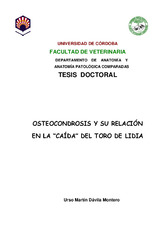Osteocondrosis y su relación en la "caída" del toro de lidia

Ver/
Autor
Dávila Montero, Urso Martín
Director/es
Méndez-Sánchez, AnicetoEditor
Universidad de Córdoba, Servicio de PublicacionesFecha
2013Materia
Toro de lidiaEncastes
Caídas del toro de lidia
Osteocondrosis (OC)
Etiología
METS:
Mostrar el registro METSPREMIS:
Mostrar el registro PREMISMetadatos
Mostrar el registro completo del ítemResumen
Osteocondrosis (OC) es un trastorno del crecimiento en el cartílago de
humanos y en los animales domésticos. En los animales, la enfermedad se ha
descrito en cerdos, perros, caballos, bovinos de raza Brahaman, gatos y ratas.
Es considerada como la causa más importante de debilidad en los miembros
posteriores de los cerdos y causa frecuente de cojeras en caballos y perros.
Parece evidente que la heredabilidad es el factor más importante en su
etiología.
Los trastornos hemodinámicos están implicados en la patogénesis de la
osteocondrosis, alterando la función del cartílago de forma directa sobre los
vasos sanguíneos, modificando las propiedades biomecánicas de las
estructuras circundantes. La necrosis de los vasos de los canales del cartílago,
parece ser el inicio de la interrupción temporal de los vasos que van desde la
médula ósea hasta el cartílago durante un estrecho margen de edad durante el
crecimiento, ocasionando un fallo focal de osificación endocondral y necrosis.
El origen de la caída ha sido causa de numerosas hipótesis y/o teorías,
desde las que atribuyen el problema a razones físicas hasta las que consideran
que el origen es genético. Se considera que la caída es un problema derivado
de múltiples factores diferenciados entre causas Predisponentes: (físicas,
psíquicas, alimentícias, parasitarias, excesiva precocidad) y Determinantes:
(medicamentos, dopado, plaguicidas, patológicas, circulatoria, nerviosas,
metabólicas, endocrinas, genéticas y etológicas).
Estas aportaciones han sido la base de nuestra investigación para relacionar
las lesiones observadas de osteocondrosis con la caída que manifiesta el toro
durante su lidia, y la idea de que este “síndrome de la caída” está
estrechamente relacionado con la heredabilidad... Osteochondrosis (OC) is a disorder of the cartilage growth in humans and
domestic animals. In animals, the disease has been reported in pigs, dogs,
horses, cattle Brahaman, cats and rats. It is considered as the most important
cause of weakness in hind limbs of pigs and common cause of lameness in
horses and dogs.
It seems clear that heritability is the most important factor in its etiology.
Hemodynamic disorders are involved in the pathogenesis of
osteochondrosis, cartilage function altering directly on the blood vessels by
altering the biomechanical properties of the surrounding structures. Necrosis of
the vessels of the cartilage seems the beginning of the temporary interruption of
the vessels leading from the marrow to the cartilage in a bone narrow age range
during growth, causing a failure of endochondral ossification and focal necrosis.
The origin of the “Fall” has caused numerous hypotheses and / or theories
from those attributed to physical causes until you consider that the origin is
genetic. It is considered that the fall is a problem caused by multiple factors
differentiated between predisposing causes: (physical, psychological,
nutritional, parasitic, excessive earliness) and Determinants (drugs, doping,
pesticides, pathological, circulatory, nervous, metabolic, endocrine, genetic and
behavioral).
These contributions have been the base of our research to relate the
lesions of osteochondrosis in the “Fall” that manifested during the bull fight, and
the idea that this "Fall syndrome" is closely related to the heritability.
This research was carried out a total of 450 male cattle breed bulls (12
yearlings, 42 steers not minced, chopped y306 90 steers bulls). Age is
expressed in months from the date of birth to the time of fighting and death. The...
